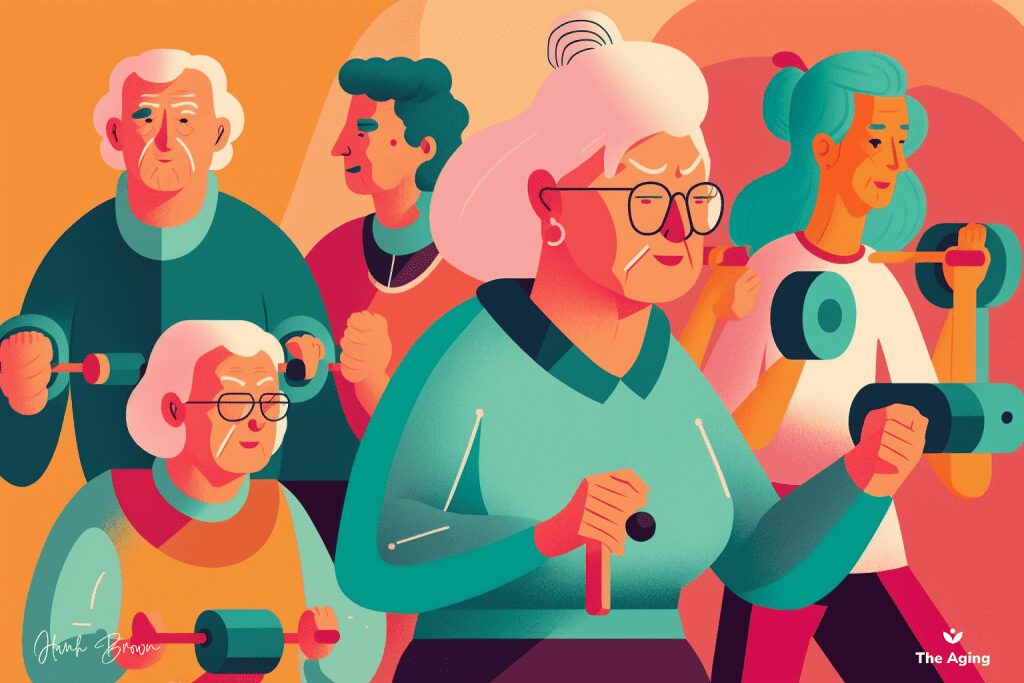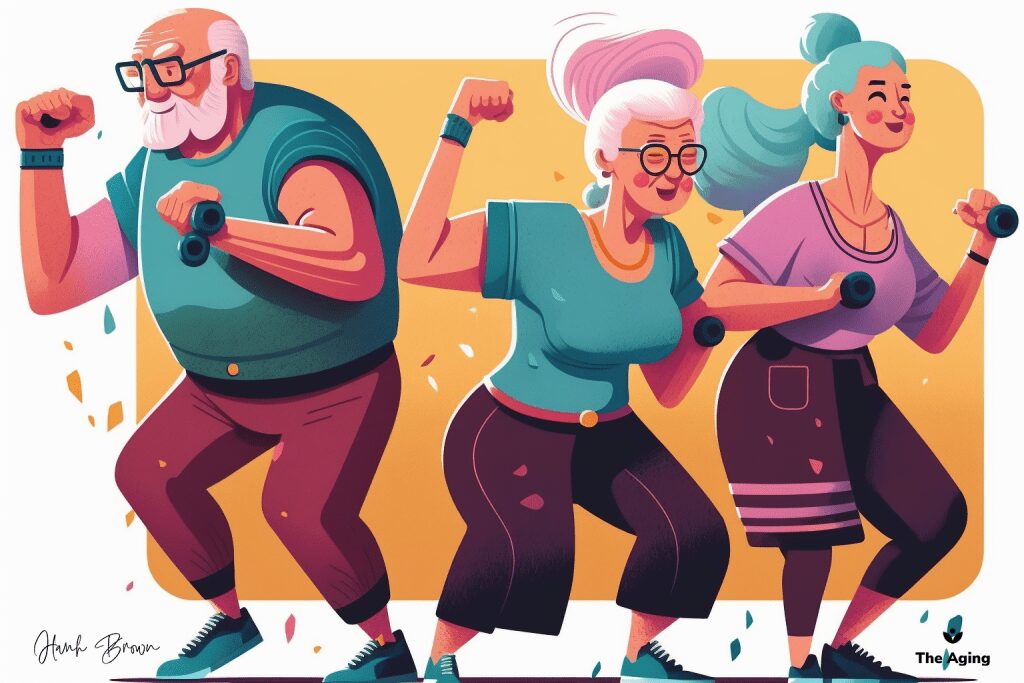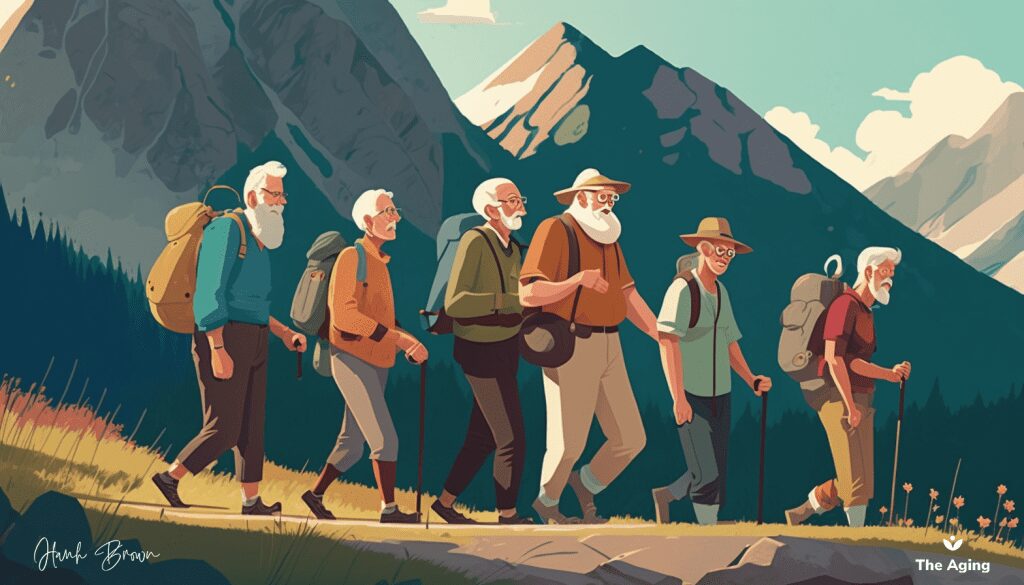Curious about the link between aging and exercise? Discover the incredible benefits of staying active as you age in our comprehensive guide. Learn how regular physical activity promotes overall health, enhances cognitive function, and supports longevity in seniors. Gain valuable insights on effective workouts, age-specific exercises, and injury prevention to remain fit and independent.
Embrace the life-changing impact of exercise in your golden years, and enjoy a more youthful, vibrant existence. Dive into the world of aging and exercise, and start your achieving the success towards a healthier, happier you today!
How Exercise Affects Ageing: A Fountain of Youth in Motion?
Regular exercise can play a pivotal role in delaying the ageing process, promoting both physical and mental well-being. As a natural way to maintain youthful vigor, exercise helps to strengthen muscles, improve cardiovascular health, and enhance cognitive function. Engaging in consistent physical activity can lead to a more fulfilling and longer life, proving that motion truly is the key to our own fountain of youth.
Does Exercise Improve Aging? Or Is It Just a Myth?
Is it possible that exercise is the key to unlocking a more youthful version of yourself? The answer is a resounding yes! Numerous scientific studies have demonstrated that engaging in regular physical activity offers a wide range of benefits that contribute to healthy aging, extending from the cellular level to overall body function and enhancing various aspects of your life.
Exercise has been proven to positively influence cellular health, promote the production of antioxidants, and combat age-related inflammation. It also leads to better cardiovascular health by improving blood circulation, reducing the risk of heart disease, and lowering blood pressure.
Benefits of Exercise on Physical Health: A Well-Oiled Machine
Think of your body as a classic car. To keep it running smoothly, you need to maintain it regularly. Exercise does just that for your body, increasing muscle mass, reducing body fat, and improving bone density. But that’s not all – it’s also the fuel that keeps your heart and lungs functioning at peak performance. So, don’t let your body collect dust in the garage; take it out for a spin and enjoy the ride!
Benefits of Exercise on Mental Health: A Rejuvenating Brain Spa
Did you know that exercising your body is like treating your mind to a relaxing, invigorating spa day? Regular & consistent physical activity has been linked to improved mood, reduced anxiety, and increased cognitive function. As we age, it’s not just our bodies that need maintenance, but our minds too. So, consider exercise as a holistic approach to keeping your brain in tip-top shape.
Does Fitness Slow Down Ageing? Or Is It Just a Race Against Time?
Fitness can indeed have a positive impact on ageing by promoting overall health and reducing age-related diseases. Engaging in regular physical activity strengthens the immune system, improves cardiovascular health, and maintains muscle mass.
Although fitness may not directly stop the ageing process, it can certainly improve one’s quality of life as they age. Therefore, incorporating an active lifestyle can be viewed as a means of combatting the negative effects of ageing rather than halting the process altogether.
The Relationship Between Fitness and Ageing: A Graceful Dance With Time
Imagine time as a dance partner, gracefully twirling you through the years. With fitness as your dancing shoes, you can better keep up with time’s tempo, adapting to life’s changes while maintaining strength and vitality. Staying active ensures a higher quality of life, allowing you to live longer and better. In essence, every step in life’s dance becomes more enjoyable when you embrace an active lifestyle.
Also read: Home Care Technology for Seniors: Enhancing Safety
The Benefits of Maintaining Fitness in Old Age: A Golden Ticket to Vitality
Who says growing older means slowing down? Embrace a healthy lifestyle and maintain your fitness as you age to continue enjoying the activities you love, while simultaneously reducing the risk of chronic illnesses. Consistent exercise enhances not only your physical health but also your mental well-being, leading to an overall improvement in your quality of life. So, go ahead and claim your golden ticket to a vibrant, fulfilling future by staying active and prioritizing fitness throughout your life’s journey.
What Slows Ageing the Most? Is There a Secret Ingredient?
Ageing is a complex process with various contributing factors. The secret ingredient to slowing it down lies in a balanced combination of regular exercise and healthy genetics. Exercise helps maintain physical and cognitive health, while genetics can predispose us to certain age-related conditions. Harnessing the power of both can lead to a more extended, higher-quality life in the race against time.
The Impact of Exercise on Longevity: The Elixir of Life
Although there isn’t a magical potion to grant us eternal youth, engaging in regular exercise could be considered the closest alternative we have. Exercise offers numerous health benefits that can contribute to a longer, more vibrant life. By lacing up your sneakers and committing to an active lifestyle, you allow the transformative power of physical activity to work its magic on your body and mind.
The Role of Genetics in Ageing: A Hand of Cards You Can Still Play
While genetics certainly contribute to the aging process, there are other factors that can play a significant role. Leading a healthy lifestyle, which includes regular exercise, can help you optimize the genes you have inherited. You don’t have to resign yourself to a predetermined fate based on your genetics; you can take charge and age gracefully with energy and vitality. By making smart choices, you can influence the way your body ages, and enjoy a more fulfilling life as you grow older.
Exercise and Physical Appearance: A Picture of Youthful Radiance
Regular exercise can contribute to a youthful and radiant appearance by improving circulation and promoting healthy skin. Strength training can also help to maintain muscle tone and prevent sagging, which can contribute to a more youthful appearance. Proper hydration, nutrition, and skincare habits can further enhance the positive effects of exercise on physical appearance.
Can Exercise Keep You Looking Younger? Is It the Secret to a Timeless Glow?
Keeping a youthful appearance is a goal many people strive for as they age. Exercise may be a secret to achieving a timeless glow. Regular physical activity can contribute to a more youthful appearance in several ways. First, it can improve blood circulation, providing a healthy glow to the skin. Second, exercise can help reduce inflammation in the body, which can lead to healthier, smoother skin.
Third, exercise can increase muscle tone and definition, providing a more youthful and vibrant appearance. Finally, regular exercise can help reduce stress, which is a significant contributor to premature aging. Overall, incorporating regular exercise into your routine can be an effective way to maintain a youthful appearance and enjoy a more vibrant, healthier life.
The Effects of Exercise on Skin Health: The Fountain of Youth for Your Complexion
Imagine if the secret to glowing, healthy skin was as simple as breaking a sweat. Well, it turns out that exercise might be the ultimate skincare routine! By increasing blood flow, exercise nourishes your skin cells with vital nutrients and oxygen, promoting collagen production and reducing inflammation. Say goodbye to expensive creams and serums and hello to the natural, rejuvenating power of exercise.
The Impact of Exercise on Hair Health: A Luscious Mane of Vitality
Does the thought of a thick, vibrant mane of hair sound enticing? Exercise could be the answer to maintaining the health and fullness of your locks. By improving circulation, exercise supports hair growth and can even help combat hair loss related to ageing. So, go ahead and let your hair down as you embrace the transformative power of physical activity.

Which Exercise Is Best for Anti-ageing? Is There a Fountain of Youth Workout?
While there may not be a single “fountain of youth” workout, there are several types of exercise that can promote anti-aging benefits. Resistance training, such as weightlifting or bodyweight exercises, can help build and maintain muscle mass, which tends to decline with age. This can help improve balance, posture, and overall strength, reducing the risk of falls and injuries.
Cardiovascular exercise, such as running or cycling, can help improve heart health and increase oxygen flow to the skin, leading to a healthy glow. Yoga and Pilates can also be beneficial for promoting flexibility, balance, and relaxation, which can help reduce stress and improve overall well-being.
The Benefits of Cardio Exercises: A Heart-Pumping Path to Longevity
Cardio exercises, such as running or cycling, are like high-octane fuel for your body, keeping your heart and lungs in tip-top shape. Regular cardiovascular your endurance, improves circulation, and even help with weight management – all essential factors for maintaining a youthful appearance and vitality. So, let your heart guide you on this energizing journey toward a more radiant, healthier self.
The Benefits of Strength Training: A Sculptor’s Chisel for the Body and Soul
Don’t be fooled into thinking that strength training is only for bodybuilders. Lifting weights, resistance training, and bodyweight exercises can work wonders for your physique and overall health. By building muscle mass and improving bone density, you’re sculpting a strong foundation to support you through the years. Plus, with increased strength and flexibility, you’ll be better equipped to maintain your independence and enjoy an active lifestyle as you age. Embrace the chisel and carve out the best version of yourself.
What Exercise Habits Slow Down Ageing After 50? A Roadmap to a Vibrant Future
As we age, exercise becomes increasingly important for maintaining a healthy and vibrant body. However, after the age of 50, it’s essential to approach fitness with a tailored approach that takes into account the changes that occur in the body over time. Here are some exercise habits that can help slow down aging after 50:
The Importance of Regular Exercise: A Steady Rhythm of Rejuvenation
Consistency is indeed key to reaping the full benefits of exercise after 50. By maintaining a regular workout routine, you can improve your physical strength and endurance while also enhancing your mental well-being. It’s important to think of exercise as a symphony of health, with each workout session contributing to a harmonious and invigorating melody.
This means finding a routine that works for you and sticking to it, whether it’s daily walks, yoga classes, or gym workouts. Additionally, it’s important to listen to your body and adjust your routine as needed to prevent injury or burnout. By incorporating a mix of resistance training, cardiovascular exercise, flexibility and balance training, and mind-body practices, you can create a roadmap to a vibrant and healthy future, no matter your age.
The Role of Nutrition in Anti-ageing: A Fine-Tuned Orchestra of Nourishment
Exercise is undoubtedly an essential component of a healthy lifestyle, but it’s not the only factor that contributes to a youthful and energetic life. Nutrition plays a crucial role in supporting exercise performance and overall health. By fueling your body with a balanced diet rich in vitamins, minerals, and antioxidants, you provide the necessary support for your exercise regimen, paving the way for a more radiant and resilient you.
Eating a variety of nutrient-dense foods, including fruits, vegetables, whole grains, lean proteins, and healthy fats, can provide your body with the fuel and nutrients it needs to thrive. Additionally, staying hydrated by drinking plenty of water can help maintain healthy skin and digestion. By pairing a consistent exercise routine with a healthy and balanced diet, you can create a harmonious symphony of health that promotes longevity, vitality, and overall well-being.
Runner’s Face and Other Myths: A Marathon of Misconceptions
Running is a popular form of exercise that offers numerous physical and mental benefits, but it’s also surrounded by many myths and misconceptions. One of the most common misconceptions is the idea of “Runner’s Face,” which suggests that running causes premature aging and facial wrinkles. Let’s acknowledge more about runner face and relevant myths.
Why Do Runners Look Younger? A Sprint Towards the Fountain of Youth
Research suggests that there is indeed a connection between running and a more youthful appearance. Running can help to reduce the signs of ageing by promoting the production of collagen, which keeps the skin looking firm and elastic. It can also improve circulation, which can result in a healthier complexion.
In addition, running is known to reduce stress and increase endorphins, both of which can have a positive effect on a person’s overall well-being and can contribute to a more youthful appearance. So, if you’re looking for a way to stay young and vibrant, lacing up your running shoes and hitting the pavement may be a great place to start.
The Relationship Between Running and Ageing: A Race Against Time
Regular running can help to reduce wrinkles and fine lines by promoting the production of collagen in the skin. This protein is essential for maintaining skin elasticity and preventing sagging, giving you a more youthful and vibrant look. Additionally, running can increase blood flow and oxygen to the skin, providing it with vital nutrients and helping to eliminate toxins.
This can result in a brighter and healthier complexion, making you look more radiant and youthful. Moreover, running can reduce stress and boost mood, leading to a more positive outlook on life. This can reflect in your appearance, as a happy and content person tends to have a more youthful and energetic demeanor.
The Effects of Running on Facial Appearance: A Runner’s Radiant Glow
While running can contribute to a healthy, glowing complexion, there is also the possibility that it could have negative effects on facial appearance. Excessive running, for example, can lead to increased sun exposure, which can cause premature ageing and skin damage. Runners who spend long hours in the sun without proper protection may be more prone to wrinkles, sun spots, and other signs of ageing.

What Is the Runner’s Face? Separating Fact From Fiction
“Runner’s face” has been a topic of much discussion in the fitness world, with many questioning whether running can lead to premature facial ageing. While there is no definitive answer to this question, some factors may contribute to the phenomenon. These can include excessive sun exposure, loss of skin elasticity due to repetitive bouncing and jostling during a run, and poor skincare habits.
However, it’s important to note that the anti-ageing benefits of regular exercise can far outweigh any potential negative effects. By practicing good sun protection and skincare habits, runners can help minimize the risk of “runner’s face” and maintain a healthy, youthful appearance.
Why Do Endurance Athletes Look So Old? A Long-Distance Journey Through Time
Endurance sports have long been associated with impressive physical feats, but the impact of these demanding activities on ageing is a topic of ongoing debate. Some researchers suggest that the stress of intense training can lead to increased inflammation, which can contribute to an aged appearance.
However, the importance of rest and recovery cannot be overstated. By allowing the body time to heal and repair, athletes can minimize the potential negative effects of inflammation and maintain a more youthful and vibrant appearance.
So, while endurance sports may pose challenges to the body, the benefits of regular exercise cannot be ignored. By prioritizing rest and recovery and adopting healthy habits, such as good nutrition and proper skincare, endurance athletes can continue to push themselves to their physical limits without sacrificing their appearance or overall health.
Fitness for Older Adults: Mastering the Art of Ageless Exercise
As we age, it’s natural to wonder when exercise might become more difficult, but there’s no specific age at which physical activity becomes universally challenging. Changes in muscle mass, bone density, and flexibility can influence our ability to exercise, but by adapting our workouts to accommodate our bodies’ changing needs, we can continue to enjoy an active lifestyle at any age.
Recognizing the effects of ageing on exercise is a crucial step in developing a tailored fitness routine that remains effective, safe, and enjoyable. Embracing the dance with time means learning to move gracefully through the years, with a focus on maintaining strength, balance, and flexibility.
Adapting exercise routines to accommodate the changes that come with ageing is essential to maintaining an active lifestyle. With the right approach, you can continue to reap the benefits of physical activity and maintain a sense of empowerment and vitality.
Remember, age is just a number, and the key to ageless fitness is adaptation and resilience. By rewriting the rules and creating a workout routine that works for you, you can master the art of ageless exercise and enjoy a lifelong journey towards health and wellness.

It can be challenging to determine if your fitness level is on par with your age, but there are several tests and tools available to help you assess your physical well-being. These may include measurements of strength, flexibility, balance, and endurance, as well as body composition and cardiovascular fitness assessments. Once you have a better understanding of your fitness level, there are many ways to improve it.
Fitness Tests for Older Adults: A Trusty Measuring Stick for Vitality
To evaluate your fitness level, consider undergoing a series of tests designed specifically for older adults. These may include assessments of strength, flexibility, and endurance, such as the chair stand test, sit-and-reach test, and the 6-minute walk test. By benchmarking your abilities, you’ll gain valuable insights into your current fitness level and areas for improvement.
Tips for Improving Fitness in Old Age: A Treasure Map to Ageless Vitality
Physical fitness is vital for good health, regardless of age. Even if you have never been a fitness enthusiast, incorporating exercise into your daily routine can make a world of difference. A mix of aerobic activities, strength training, flexibility exercises, and balance drills can enhance physical well-being and improve overall quality of life.
Regular workouts are key to making steady progress towards fitness goals, so it’s important to make exercise a consistent part of your routine. Don’t be discouraged if you are new to fitness – it’s never too late to start! Start small and build up gradually, and before you know it, you’ll be feeling fitter, stronger, and more energized than ever before.
How Far Should a 60 or 65-Year-Old Walk Every Day? A Stride Towards Optimal Health
Walking is an excellent low-impact exercise for older adults, offering a range of physical and mental health benefits. While there’s no one-size-fits-all answer to the question of how much walking is ideal for those aged 60 or 65, there are some general guidelines to follow.
Health experts recommend aiming for at least 30 minutes of moderate-intensity walking most days of the week to improve cardiovascular health, manage weight, and enhance overall well-being. However, individual needs may vary depending on factors such as overall fitness level, health status, and personal preferences.
The Benefits of Walking for Older Adults: A Stroll Down the Path of Wellness
Walking offers a myriad of health advantages for older adults, including improved cardiovascular health, weight management, and enhanced mood. As a low-impact exercise, it’s also gentle on the joints, making it an accessible and enjoyable option for individuals of all fitness levels.
Recommended Walking Distances for Older Adults: A Well-Trodden Roadmap to Fitness
It’s important to note that individual needs and abilities may vary, and it’s always best to consult with a healthcare professional before beginning a new exercise routine. Older adults who are new to exercise or have health conditions that may limit their ability to walk should start slowly and gradually increase their activity level over time.
Walking can be combined with other physical activities, such as swimming, cycling, or yoga, to create a well-rounded exercise routine that incorporates cardiovascular, strength, and flexibility training. By tailoring a fitness plan to individual needs and interests, older adults can enjoy the benefits of exercise and achieve their fitness goals.

What Exercises Are Successful for Ageing? A Recipe for a Rejuvenating Workout
As we age, it’s important to recognize the changes in our bodies and adapt our exercise routines accordingly. While there is no one-size-fits-all answer to the question of which workouts are best suited for the ageing process, a combination of cardiovascular, strength, and flexibility training can be effective in maintaining physical health and vitality. Variety is crucial in crafting an anti-ageing exercise plan. Including a mix of exercises that challenge the body in different ways can help to prevent boredom and reduce the risk of injury.
The Importance of Variety in Exercise Routines: A Symphony of Health and Harmony
Think of your exercise routine as a well-orchestrated symphony, where each instrument plays a vital role in creating a harmonious melody. A balanced and varied workout plan should include aerobic activities for cardiovascular health, strength training to maintain muscle mass, flexibility exercises to promote joint mobility, and balance drills to reduce the risk of falls. By incorporating a diverse mix of exercises, you’ll be better equipped to tackle the challenges of ageing while enjoying a dynamic and engaging fitness journey.
The Benefits of Yoga and Other Low-Impact Exercises: A Gentle Path to Ageless Vitality
Low-impact exercises like yoga offer a plethora of benefits for those seeking a more gentle approach to ageing. These workouts focus on flexibility, balance, and core strength, making them ideal for older adults looking to maintain functional fitness and reduce the risk of injury. Moreover, the meditative aspects of practices like yoga and tai chi can help alleviate stress and promote mental well-being, further enhancing your overall quality of life.
Conclusion
The link between aging and exercise is a secret to stay young and fit. By incorporating a blend of aerobic activities, strength training, flexibility exercises, and low-impact workouts like yoga, you’ll be well on your way to maintaining a youthful and vibrant lifestyle as you age. So, lace up your sneakers, unroll your yoga mat, and dive into the world of age-defying fitness – a brighter, healthier future awaits.
FAQs
What types of exercises should older adults focus on to maintain overall health and well-being?
To maintain physical health and prevent age-related declines, older adults should prioritize a balanced exercise routine. This should include aerobic activities to promote cardiovascular health, strength training to preserve muscle mass, flexibility exercises for joint mobility, and balance drills to reduce the risk of falls. By incorporating each of these components, older adults can achieve a well-rounded exercise regimen that supports overall physical well-being and a vibrant quality of life.
How often should older adults engage in physical activity?
It’s generally recommended that older adults aim for at least 150 minutes of moderate-intensity aerobic exercise or 75 minutes of vigorous-intensity aerobic exercise per week, spread across several days. Strength training exercises should be performed at least twice a week, targeting all major muscle groups. Flexibility and balance exercises can be incorporated into daily routines or practiced several times a week, depending on individual needs and preferences.
Are there any precautions that older adults should take when starting a new exercise routine?
Older adults should consult with a healthcare professional before beginning any new exercise program, especially if they have pre-existing health conditions or concerns. It’s important to start slowly and gradually increase the intensity and duration of workouts, paying close attention to proper form and technique. Listening to your body and making adjustments as needed is crucial for ensuring a safe and effective exercise routine.
Can exercise help mitigate the effects of common age-related health issues, such as arthritis or osteoporosis?
Yes, regular physical activity can play a significant role in managing and even preventing many age-related health conditions. Strength training and weight-bearing exercises can improve bone density, reducing the risk of osteoporosis. Exercise can also help manage chronic conditions like diabetes and heart disease by improving cardiovascular health and promoting weight management.
Resources
- https://www.health.harvard.edu/
- https://www.health.com/
- https://healthyhumanlife.com/
